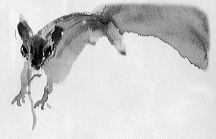
Chez Maggie
Hotel & Restaurant
Morondava
Chez Maggie / TRIPADVISOR: 2012, 2013 & 2014 Certificates of Excellence
| Sustainable Tourism |
| Responsible Travel Links |
| Safety, Health & Communication |
| International Travel Issues & Embassy Links |
| Country Information & Tour Information |
| Booking Procedure Travel Documents |
| Getting There |
| Request Information |
Gallery: Natural History |
|
 rainy weeks and to be much less
active the rest of the year. For example,
five-foot-long Leioheterodon snakes pass the
dry months several feet below ground, curled up in
a nest of ants, and emerge only after the rain
begins. Similarly, many of Kirindy's birds spend
the harsh months in other parts of Madagascar or in
Africa or Europe. None of these pattern are
surprising. Many birds migrate, and many of the
world's frogs, lizards, and snakes lie low during
cooler periods of the year. Some of the lemurs and
other mammals Kirindy, however, are quite another
story, a striking exception to the rule that
tropical mammals generally do not exhibit strong
seasonal variations in activity. Most puzzling
among them are several species that hibernate even
when the weather is warm. Verreaux´s sifakas
(Propithecus verreauxi verreauxi) are the
most prominent inhabitants of Kirindy. rainy weeks and to be much less
active the rest of the year. For example,
five-foot-long Leioheterodon snakes pass the
dry months several feet below ground, curled up in
a nest of ants, and emerge only after the rain
begins. Similarly, many of Kirindy's birds spend
the harsh months in other parts of Madagascar or in
Africa or Europe. None of these pattern are
surprising. Many birds migrate, and many of the
world's frogs, lizards, and snakes lie low during
cooler periods of the year. Some of the lemurs and
other mammals Kirindy, however, are quite another
story, a striking exception to the rule that
tropical mammals generally do not exhibit strong
seasonal variations in activity. Most puzzling
among them are several species that hibernate even
when the weather is warm. Verreaux´s sifakas
(Propithecus verreauxi verreauxi) are the
most prominent inhabitants of Kirindy.  These long-legged, seven-pounds lemurs, white
with dark patches, leap among tree trunks high in
the canopy, propelled by their powerful hind legs
but continually maintaining an upright posture.
Like the vast mjority of primates elsewhere in the
world, they live in small, cohesive groups of two
to eight members and are active exclusively during
the day. Sifakas have teeth and guts that are
specialized for feeding on leaves, but they adapt
their menu opportunistically as different flowers
and fruits come into season. These lemurs cope with
the long dry season primarily by expending less
energy, sometimes having the distance they travel
each day and the time they devote to foraging and
other activities. Sifakas´ body temperature
falls a few degrees at night, another
calorie-saving adaption; These long-legged, seven-pounds lemurs, white
with dark patches, leap among tree trunks high in
the canopy, propelled by their powerful hind legs
but continually maintaining an upright posture.
Like the vast mjority of primates elsewhere in the
world, they live in small, cohesive groups of two
to eight members and are active exclusively during
the day. Sifakas have teeth and guts that are
specialized for feeding on leaves, but they adapt
their menu opportunistically as different flowers
and fruits come into season. These lemurs cope with
the long dry season primarily by expending less
energy, sometimes having the distance they travel
each day and the time they devote to foraging and
other activities. Sifakas´ body temperature
falls a few degrees at night, another
calorie-saving adaption;
|
|
<<< previous page |
next page >>> |
Remote River Expeditions in Madagascar, Ethiopia, Tanzania - River Trips and Tours
Experience the romance of East Africa. We invite you to join one of Remote River Expeditions' adventures into Madagascar, Ethiopia, and Tanzania and see the atrractions of those countries. Each trip is completely unique. Each expedition has its own special challenges and serendipitous, human connections. What you can expect in every instance, however -- and why many of our clients return, year after year - is an outstanding wilderness experience including great food, magnificent wildlife, and friendships forged that last a lifetime.remote, rivers, rivertrips, river, trip, tour, rafting, east, africa, madagascar, ethiopia, tanzania, rafting, tour, camping, trip, expedition, challenge, wilderness, animals, birds, lemmer, gary, gallery, expeditions, birding, gameviewing, watercolor, paint, painting, whitewater, paddling, vacation, beach, Selous, Omo River, Rufiji River, Zambezi, Tsiribihina, Mangoky river, scenic, natural, cultural, conservation, floral, fauna, lemurs, safaris, Zambezi, birdwatching, adventure, exploration, Afrika, nature, Africa
All Rights Reserved
© 2001-2025 RRE
© 2001-2025 RRE



